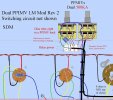ledvedder
Well-Known Member
How to you compensate for the bias change, if you're changing voltage on the fly? When I built my Plexi, I added a switch that adjusts the bias appropriately for 120v or 90v.I use a variac. I run my amp on full blast, even the eq knobs (presence to taste though). Hendrix/early EVH tone for days, gets the power tubes cooking. But the problem is it’s too loud! That’s where the variac comes in. I adjust the voltage to the amp down—same tone but less than half the volume. Very manageable. So then I rigged a very long bolt on the knob of the variac so I can adjust the volume with my foot while playing. I’m in a 2 guitar band. I need a volume boost for my solo? Kick the voltage up. I have a whole lot of volume at my disposal now and I don’t have to sacrifice tone in any way.


